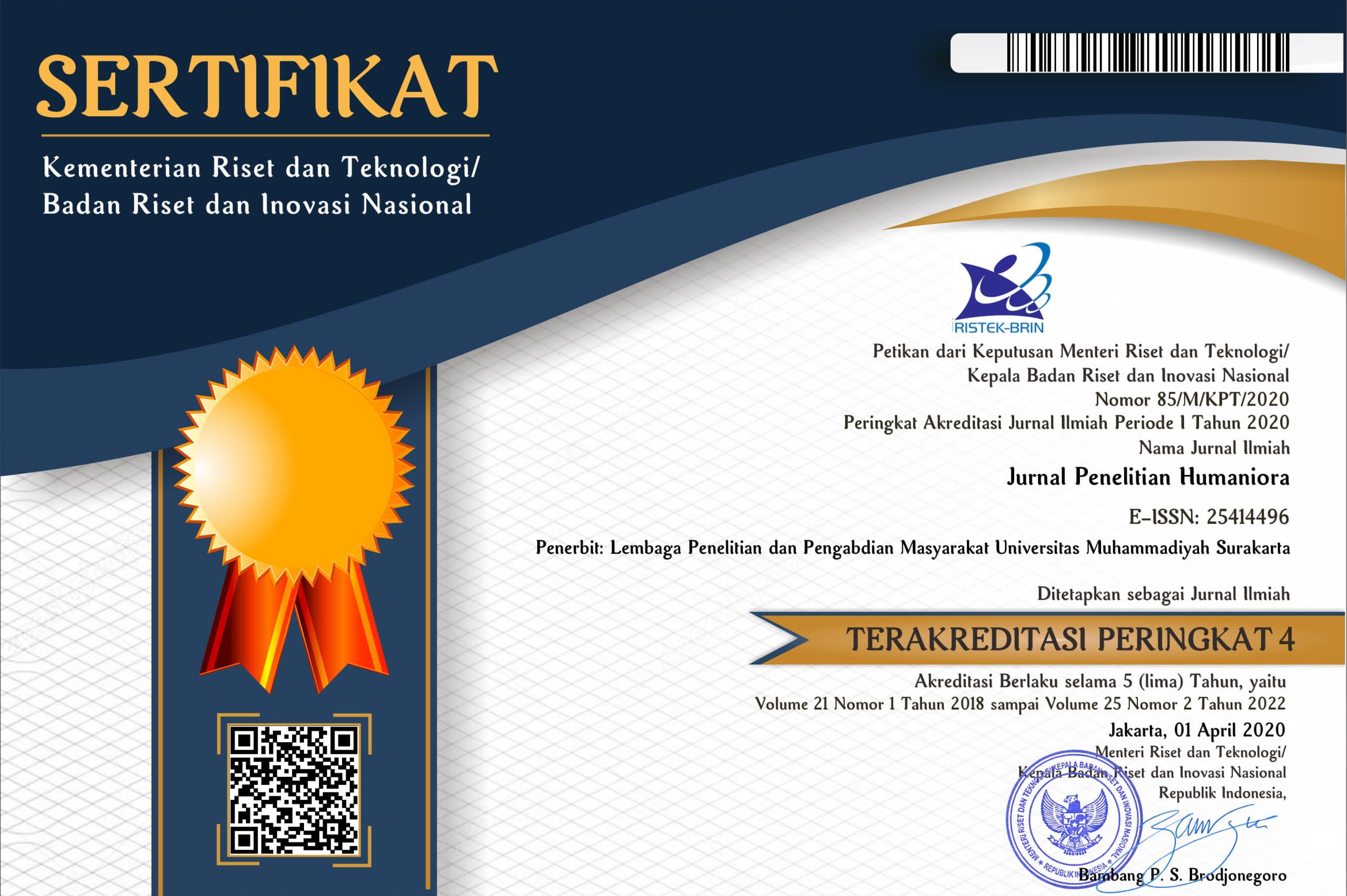LANGUAGE FORM AND FUNCTION OF CARETAKERS FOUND IN NANNY MCPHEE AND THE BIG BANG MOVIE
Aditya Putri Kusuma Andani(1*)(1) MTsN Surakarta Jl. MT. Haryono No. 24-D Manahan Solo
(*) Corresponding Author
Abstract
This study deals with the form and the function of caretaker speech which is found in caretaker’s utterance in Nanny McPhee and The Big Bang Movie. The objectives of this study are (1) to describe the type of language form of the caretaker and (2) to describe the type of language function of the caretaker found in Nanny McPhee and The Big Bang Movie. The type of this research is descriptive qualitative research. The data of this research are the utterance from the caretaker found in manuscript of Nanny McPhee and The Big Bang Movie. The data collection technique is documentation. The technique of analyzing data are descriptive qualitative. The writer uses the theories from Frank (1972) to analyze the type of language form, and M.A.K. Halliday (1977) to analyze the type of language function. The result of this study shows that (1) there are four types of word: noun, verb, adjective, and adverb; three types of phrase: noun phrase, verb phrase, and adverb phrase; and two types of sentence categorized into two. The first category is based on type, namely: declarative, imperative, interrogative, and exclamatory sentence; the second one by number of full predication, namely: simple, compound, complex, and compound-complex sentence. (2) The writer found 6 types of language function, they are: regulatory function, instrumental function, representational function, personal function, interactional function, and imaginative function.
Keywords
Full Text:
PDFReferences
Bloomer, Aileen; Griffiths, P.; &Merrison, R. J. (2005). Introducing Language in Use. USA and Canada: Routledge Taylor and Francis Group.
Fauziati. Endang. (2011). Psycho Linguistics an Introduction. Surakarta: Muhammadiyah University Press.
Frank, Marcella. (1972). Modern English: A Practical Reference Guide. New Jersey: Prentice Hall, Inc.
Halliday, M.A.K., (1977). Learning How to Mean: Explorations in the Development of Language. Elsevier North-Holland, Inc., New York.
Husna, Nisaul. (2007). Variation of Utterances Used in Children Films Manuscript (Pragmatics Approach). Unpublished Research Paper. Surakarta. Muhammadiyah University of Surakarta.
Matychuk, Paul. (2005). The Role of Child-Directed Speech in Language Acquisition: A Case Study. Language Sciences, 27, 301-379.
Snow, Catherine E., Ferguson, Charles A., (1977). (Eds.), Papers from a Conference Sponsored by the Committee on Sociolinguistics of the Social Science Research Council (USA): Mothers Speech Research: from Input to Interaction. Cambridge University Press, Cambridge, pp. 31–49.
Tiritilli, Tracy L. Ways in which Child-Directed Speech Combines with Social Interaction to Facilitate the Development of Language.
http://students.english.ilstu.edu/tltirit/repurposing/homepage.htm. Accessed in April 13th, 2014, 01.00 P.M.
Whyatt, Boguslawa. (1994). Baby Talk – The Language Addressed to Language-Acquiring Children: A Review of the Problem. Studia Anglica Posnaniensia, 29, 126-128.
Yule, George. (2006). The Study of Language. Third Edition. New York. Cambridge University.
Article Metrics
Abstract view(s): 552 time(s)PDF: 390 time(s)
Refbacks
- There are currently no refbacks.











